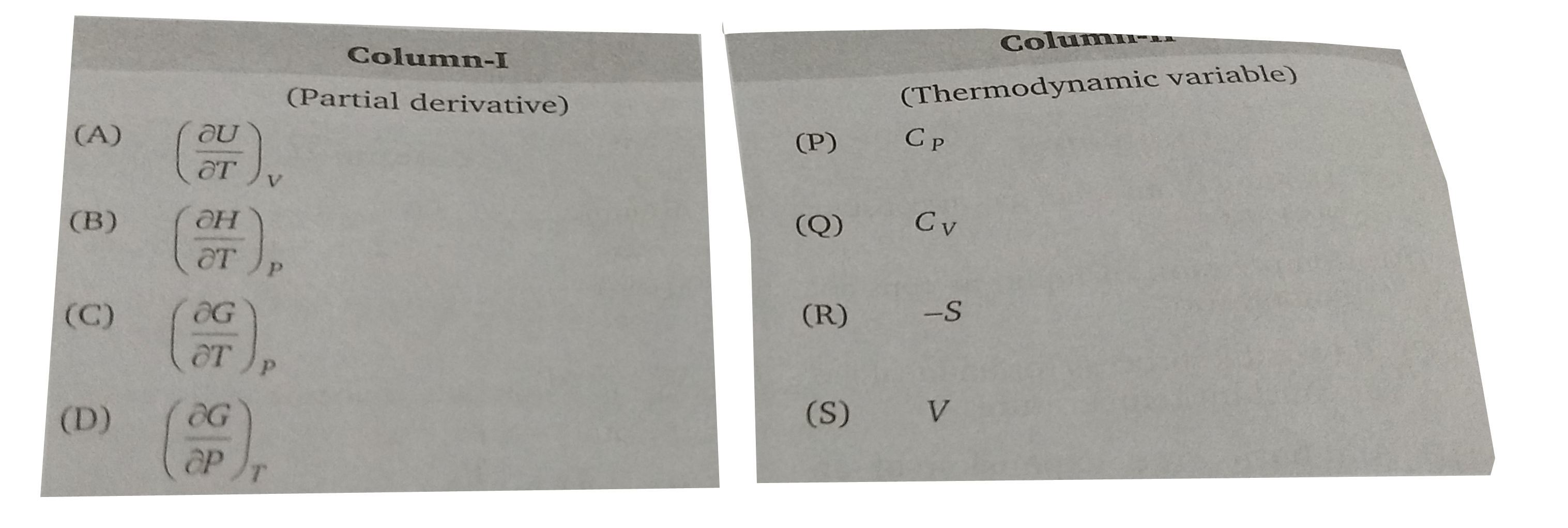Molar heat capacities at constant pressure for A, B and C are 3, 1.5 and 2 J/K mol. The enthalpy of reaction and entropy of reaction, A + B → 3C are 20 kJ/mol and 20 J/K mol at 300 K. Calculate ΔG (in kJ / mol) for the reaction,
12A+B→32CSolution in Punjabi
The correct Answer is:7
Step by step video & image solution for Molar heat capacities at constant pressure for A, B and C are 3, 1.5 and 2 J/K mol. The enthalpy of reaction and entropy of reaction, A + B rarr 3C are 20 kJ/mol and 20 J/K mol at 300 K. Calculate DeltaG (in kJ / mol) for the reaction, (1)/(2)A+Brarr(3)/(2)C by Chemistry experts to help you in doubts & scoring excellent marks in Class 11 exams.
Topper's Solved these Questions
- BOOK - NARENDRA AWASTHICHAPTER - THERMODYNAMICSEXERCISE - Level 3 - One Or More Answers Are Correct1videos
THERMODYNAMICS
- BOOK - NARENDRA AWASTHICHAPTER - THERMODYNAMICSEXERCISE - Level 3 - Match The Column2videos
THERMODYNAMICS
- BOOK - NARENDRA AWASTHICHAPTER - THERMODYNAMICSEXERCISE - Level 2 (Q.1 To Q.30)1videos
THERMODYNAMICS
- BOOK - NARENDRA AWASTHICHAPTER - STOICHIOMETRYEXERCISE - Level 3 - Subjective Problems20videos
STOICHIOMETRY
Similar Questions
Assume ideal gas behaviour for all the gases considered and neglect vibrational degrees of freedom. Separate equimolar sample. Separate equimolar samples of Ne, O2 , CO2 and SO2 were subjected to a two process as mentioned. Initially all are at same state of temperature and pressue.
Step I → All undergo reversible adiabatic expansion to attain same final volume, which is double the original volume thereby causing the decreases in their temperature.
Step → After step I all are given appropriate amount of heat isochorically to restore the original temperature.
Mark the correct option(s) :02:06View SolutionMatch the following columns
 03:49View Solution
03:49View SolutionWrite structure of 2,2-dimethylheptane.
01:39View SolutionWhat volume of a liquid (in L) will contain 10 mole ? If molar mass of liquid is 280 and its density is 1.4 g/mL.
07:44View SolutionFor the reaction, 2NO_(g) + O_(2)(g) rarr 2NO_(2)(g) Calculate DeltaG at 700K when enthalpy and entropy changes are -113.0 kJ mol^(-1) and -145 J K^(-1) mol^(-1) , respectively.
02:21View SolutionEnthalpy and entropy changes of reaction are 40.63 kJ mol^(-1) and 108.8 J K^(-1) mol^(-1) , respectively. Predict the feasibility of the reaction at 27^(@)C .
05:31View SolutionMolar heat capacities at constant pressure for A, B and C are 3, 1.5 and 2 J/K mol. The enthalpy of reaction and entropy of reaction, A + B → 3C are 20 kJ/mol and 20 J/K mol at 300 K. Calculate ΔG (in kJ / mol) for the reaction,
12A+B→32C05:13View SolutionThe molar heat capacities at constant pressure (assume constant with respect to temperature) of A, B and C are in ratio of 1.5:3.0:2.0. If enthalpy change for the exotherimic reaction A+2B→3C at 300K is −10kJ/mol & Cp.m (B) is 300 J/mol then enthalpy change at 310 K is:
03:31View SolutionA reaction is at equilibrium at 100^(@)C and the enthalpy change for the reaction is "42.6 kJ mol"^(-1) . What will be the value of DeltaS in "J K"^(-1)"mol"^(-1) ?
03:43View SolutionFor the reaction A hArr B, DeltaE for the reaction is –33.0 kJ mol^(–1) . Calculate equilibrium constant K_C for the reaction at 300 K
03:41View SolutionFor a reaction, A2+B2⇔2AB,ΔGandΔS values are 20 kJ/mol and −20 J/K/mol respectively at 200k. ΔCP is 20JK−1. Then identify the correct property of the reaction.
05:06View Solutionकोई अभिक्रिया 100∘C पर साम्यावस्था में है तथा अभिक्रिया के लिए एन्थैल्पी परिवर्तन 42.6 kJ mol−1 है। JK−1mol−1 में ΔS का मान क्या होगा?
01:06View SolutionMolar heat capacities at constant pressure for A, B and C are 3, 1.5 and 2 J/K mol. The enthalpy of reaction and entropy of reaction, A +2 B rarr 3C are 20 kJ/mol and 20 J/K mol at 300 K. Calculate DeltaG (in kJ / mol) for the reaction, (1)/(2)A+Brarr(3)/(2)C
01:45View Solutionएक निश्चित अभिक्रिया के लिए एन्थैल्पी और एन्ट्रापी में परिवर्तन क्रमशः 40.63 KJ mol−1 व 100 J K−1mol−1 है 27∘C पर ΔG का मान क्या है
03:35View SolutionA reaction is at equilibrium at 100∘C and the enthalpy change for the reaction is 42.6 kJ mol−1. What will be the value of ΔS in J K−1mol−1?
02:11View Solution

